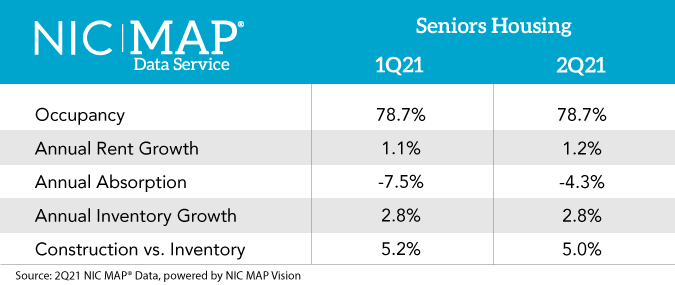ANNAPOLIS, Md. — Private-pay seniors housing occupancy remained flat in the second quarter of 2021, holding at 78.7 percent, according to new NIC MAP data, powered by NIC MAP Vision. Though COVID-19 cases in senior living properties dropped significantly in the last quarter, occupancy has not turned the corner, largely due to new inventory coming online.
That’s according to new data from the National Investment Center for Seniors Housing & Care (NIC), an Annapolis-based nonprofit firm that tracks industry data gathered from 31 primary metropolitan markets. Private-pay seniors housing comprises independent living, assisted living and memory care.
Despite unchanged occupancy, demand for seniors housing improved in the second quarter. NIC MAP reported the first positive quarterly absorption — the number of units leased on a net basis — since the first quarter of 2020 and the most positive absorption since 2019.
“Second-quarter data confirms anecdotes that occupancy at many properties improved as move-ins accelerated thanks to limited property-level COVID-19 infections,”says Beth Burnham Mace, NIC’s chief economist. “However, inventory grew and outpaced demand, and that’s why we aren’t seeing an occupancy uptick.”
Assisted living and independent living properties both experienced little change in occupancy, with independent living holding steady at 81.8 percent, and assisted living inching up to 75.5 percent.
A deeper look at the data show that a growing number of operators are reporting occupancy increases. In the second quarter of 2021, 47 percent of seniors housing properties in the NIC MAP primary markets reported an increase in occupancy. During the height of the pandemic, that number was 22.5 percent.
“Some areas of the country are seeing seniors housing occupancy improve, but the data show that we haven’t fully turned the corner,” says Chuck Harry, NIC’s chief operating officer. “Seniors housing occupancy remaining unchanged suggests that it will likely take more time to see broad, nationwide improvement to the levels prior to the onset of the pandemic.”

